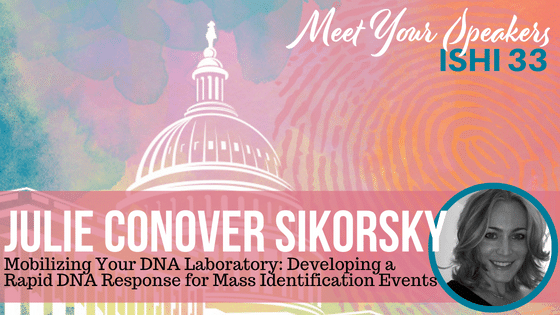In August of 2020 the Palm Beach County Sheriff’s Office Forensic Biology Unit (FBU) went on- line with a Rapid DNA program. Their goals were three-fold: 1) incorporate this technology into their regular casework cadence; 2) establish a Rapid DNA infrastructure within their service area; and 3) develop a plan to mobilize this technology should a need arise.
In 2021 the FBU began discussions with Marshall University’s Forensic Science Center regarding the development of a mass identification guidance document specific to forensic biology laboratories. The goal of this collaboration was to develop a blueprint for the mobilization of Rapid DNA that could be adapted and used by any Forensic Biology Unit.
In her presentation at ISHI 33 this year, Julie will highlight the importance of having a mass identification plan, outline the efforts that went into the FBU’s plan development, and discuss the execution of a mass identification exercise which was predicated on the discovery of a human trafficking event. We chatted with her to learn which which sample types work well with Rapid technology, what led PBSO to implement their Rapid DNA program, and advice for other labs looking to do the same.
Which sample types does Rapid DNA technology perform well on and which sample types should not be analyzed on a Rapid DNA platform?
Rapid Technology is best reserved for higher template samples (avoiding touch DNA samples) that are single source in origin. Mixtures should be avoided as the dynamic range of the current instrumentation does not allow for the reliable deconvolution of mixtures.
Why is Rapid DNA technology particularly powerful for disaster and mass identification events?
Rapid DNA, while fast by design, is an incredibly convenient all-in-one DNA analysis system. In addition, it’s portability makes it an ideal solution for mobilizing a DNA laboratory which makes it useful during mass identification events.
What led the Palm Beach Sheriff’s Office to implement a Rapid DNA Program? Were there any unexpected challenges that arose in the process?
PBSO realized the potential benefit of using Rapid DNA analysis early on, having been involved with its development since the early 2000’s. In 2012 we were able to evaluate one of the first commercially available systems. We’ve followed the evolution of the Rapid instruments, finally purchasing our first Rapid instruments in 2019. As with any new technology there are bound to be bumps in the road. As “early adopters” of this technology, PBSO has been candid with the manufacturers regarding instrument and consumable challenges – having had to revalidate instruments multiple times as improvements are made.
PBSO went live with our Rapid DNA Program for casework in August of 2020, conducting modified rapid analysis on oral buccal samples and uploading eligible profiles into CODIS. Rapid is used for paternity and identity cases, CODIS confirmation hits, oral standards, and off-ladder allele confirmations. In November of 2021 we added the ability to conduct analysis on human remains samples for the purpose identification.
In early 2021 PBSO began talks with Marshall University on the prospect of a collaboration to develop a Rapid DNA mobilization plan for mass identification events. This eventually led to PBSO funding a TAP intern using grant funds and culminating in the presentation I will be delivering at ISHI this year.
If you could give only one piece of advice for labs considering implementing a similar program, what would it be?
Speaking to the implementation of our Rapid DNA mobilization program – dedicate regularly scheduled focus time to developing a program. It’s a marathon, not a sprint. It took us over a year (and many people) to create, refine, and pilot a mass id program.
What tips would you give to someone who is just starting out in the field of forensics, or what is the best advice that you’ve received?
This is a career; it is not a job. Perfection is expected. It requires dedicated individuals to work hard and do the right thing the right way, all the time. The rewards are immeasurable.
If you had to pick one thing, what do you enjoy most about your job?
Knowing that what I do (and love to do) on a daily basis has the potential to make a difference in people’s lives, bringing them closure and security.
If you currently work in the lab, or have in the past, what’s the weirdest thing you’ve ever collected DNA from?
The first thing that comes to mind was a broken dreadlock left behind at a home invasion.
If you could have dinner with anyone (dead or alive), who would it be? Why?
Ruth Bader Ginsburg. I have so much respect for a woman, a wife, and a mother who, facing and overcoming so much adversity in her own life, sought and succeeded at living a life dedicated to fighting the inequities levied on others. She also seemed accessible, so dinner with her would undoubtedly be an easy, relaxed affair with quality conversation and good wine.
If you’ve attended ISHI in the past, what do you most enjoy about coming to the conference? If you haven’t, what are you most looking forward to?
The connections. ISHI is a hot spot for networking, finding a kindred spirit(s) in the crazy world that is forensic DNA analysis. The content of the workshops and presentations aren’t bad either (insert winky face!).
What’s one thing that others may not know about you?
I was a Girl Scout from brownies through seniors (there were no daisies when I started) and was even a Boy Scout Explorer in high school.
WOULD YOU LIKE TO SEE MORE ARTICLES LIKE THIS? SUBSCRIBE TO THE ISHI BLOG BELOW!
SUBSCRIBE NOW!


